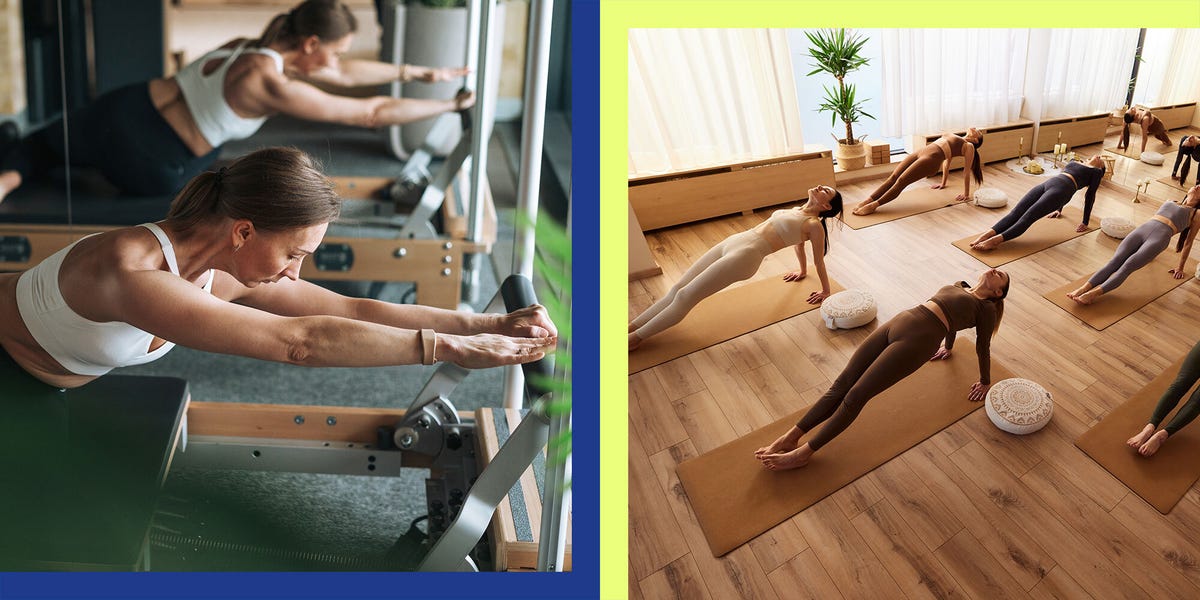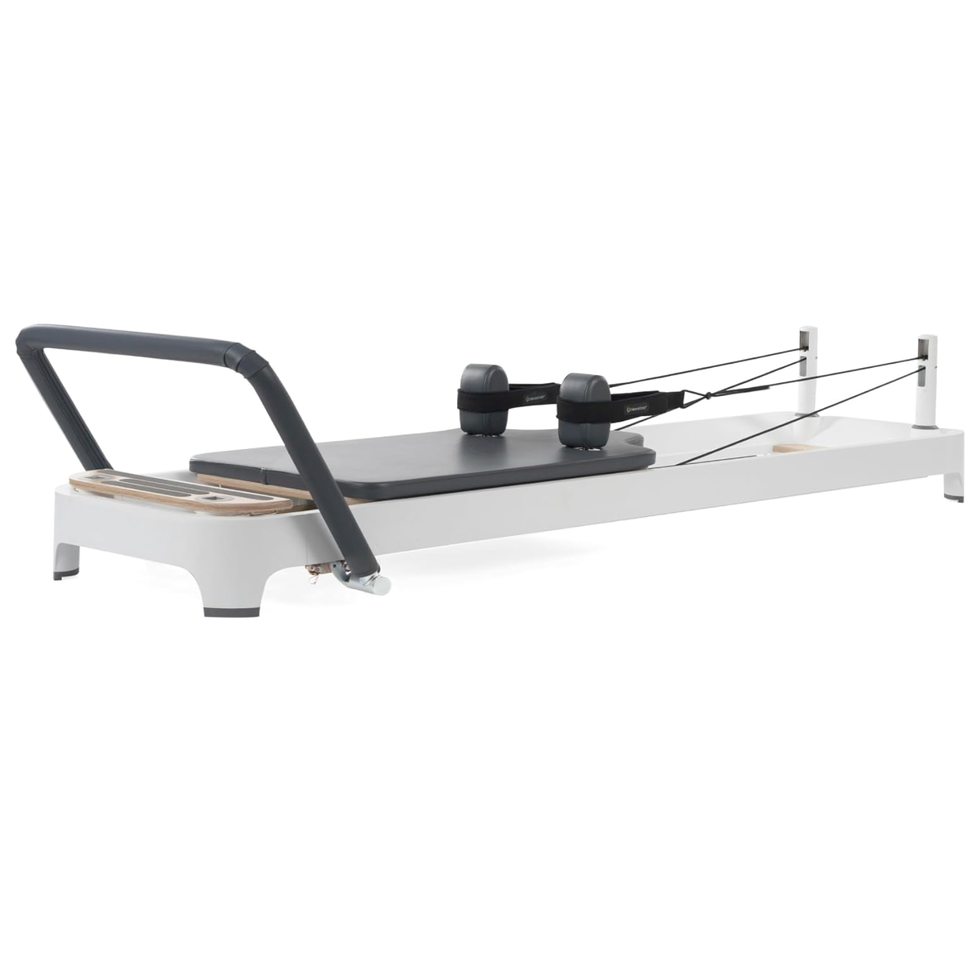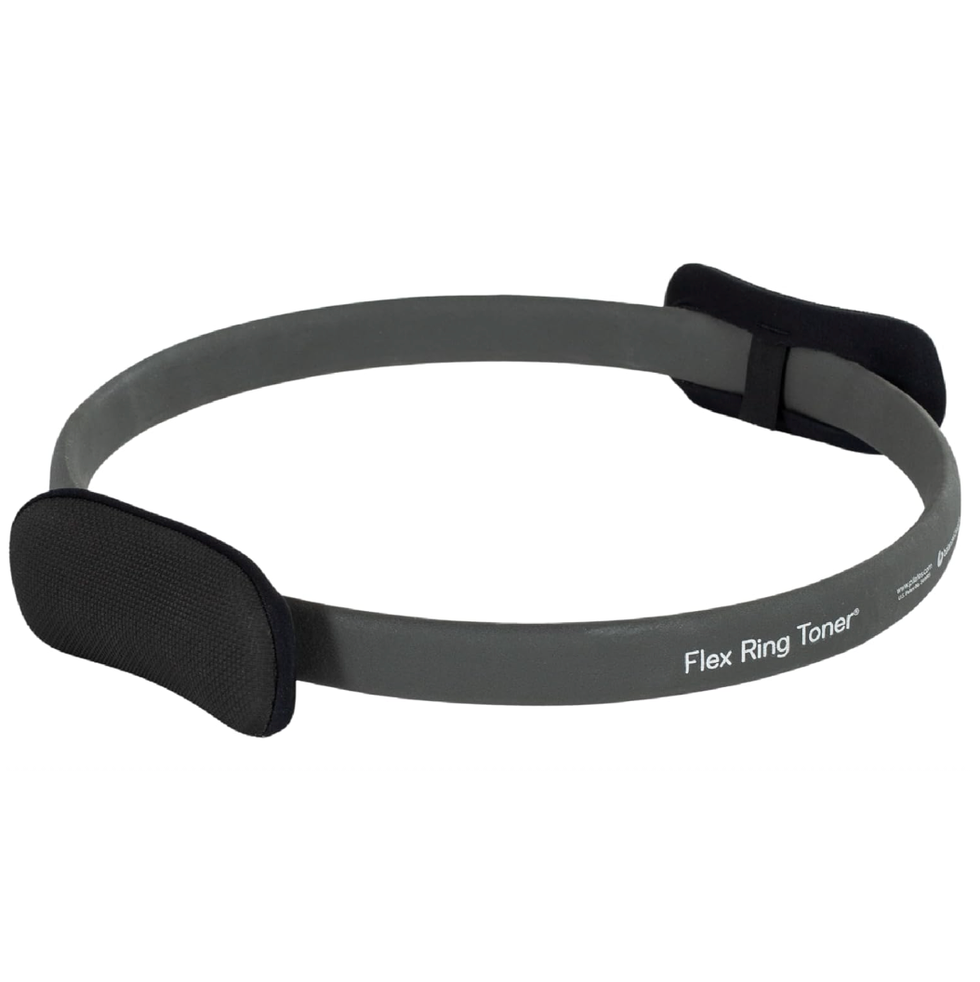If you feel like all of your friends started taking up pilates last year, it’s not in your head. There’s no doubt about it: Pilates is growing in popularity. In fact, it was the most booked fitness class last year, according to the ClassPass 2024 Look Back Report. And its demand isn’t showing signs of slowing down any time soon—if you’re like me, it’s all you see when scrolling through TikTok and Instagram.
There are two main types of this workout method: mat pilates and reformer pilates. “Mat pilates is done on a mat—a yoga mat, a specially raised pilates mat, or even a towel—and uses body weight for resistance,” says Laura Scholz, a certified classical pilates teacher. “Reformer pilates is done on a machine called a reformer. The machine is basically a raised mat that moves with springs for resistance and has straps for your hands and feet.”
Meet the experts: Laura Scholz is a certified classical pilates teacher based in Atlanta. Lindsay Matthews is a National Pilates-certified teacher in Los Angeles.
Mat and reformer pilates can both build strength, improve flexibility, and support better posture, but the one you pick should be based on your overall goals—for instance, one form might be better for increasing strength than the other, says Lindsay Matthews, a National Pilates-certified teacher in Los Angeles.
So, which pilates modality is right for you? Ahead, instructors dig into the pros and cons of reformer pilates versus mat pilates so you can get in on the action.
The Benefits Of Mat Pilates
It’s low-impact.
Mat pilates is gentle on your joints (as opposed to a high-impact workout involving running or jumping, which puts a lot of load on your body), says Scholz. In fact, it’s lower impact than reformer pilates because you’re using just your body weight versus the increased resistance of a reformer. That makes mat pilates a great option for people who experience joint pain, are recovering from an injury, or have mobility issues, for instance.
You can do it anywhere.
Mat pilates can be a zero-equipment workout, as opposed to reformer pilates, which you need, well, a reformer to do, says Scholz. If you do opt to work in pilates accessories like a ball, ring, or sliders to enhance your workout, they are also small enough to travel with if you want to. But none of these props are 100-percent necessary for a solid mat pilates workout.
So, “you can do mat pilates anywhere—at home on a yoga mat or towel or traveling in a hotel room,” she says. You can also follow YouTube videos if you can’t make it to your favorite class in person.
Potential Drawbacks Of Mat Pilates
You may need a base level of strength to get started.
Mat pilates can be tough if you’re starting from square one, says Matthews. “For example, classic exercises like the hundred or single-leg stretch require you to hold your head, neck, and chest up without the support of hands behind your head,” she says, adding that clients often need pre-existing core strength in order to do these moves without straining their necks.
It can be easy to use improper form.
Many people doing mat pilates are in a massive group class or on their own at home watching a video, so they may not be aware of the best form to use, Matthews says. For example, maybe you bend your knees in a certain movement, but straightening them would actually be best to take pressure off of your low back, she says.
Doing moves with improper form can cause pain or even injury, Matthews explains. “I recommend going to a private or small group class at least a couple of times if you’re able to so that you can really learn your body before diving in,” she says.
The Benefits Of Reformer Pilates
It may be more intense (and challenging) than mat pilates.
“The beauty of the reformer is that it builds on the mat exercises using springs as resistance,” says Matthews. “So for some exercises, the reformer may be creating an extra challenge.” The straps and springs on a reformer add intensity to movements and can help work your deep core muscles more and is more similar to strength training, Scholz says, which is why it’s harder on the reformer as opposed to the mat.
Take leg circles, for instance. On a mat, you’re circling your legs against no resistance, but on the reformer, your feet are in the straps, which provides tension. Plus, the swan (a spinal extension) is also exactly the same on the mat and reformer, but the springs on the reformer add resistance, and the lift from the footbar or box allows for greater range of motion, Scholz says, which gives your muscles a better workout because they’re being used at a greater capacity.
It trains traditional strength training moves at a lower impact.
“The reformer can be so effective at training muscle patterns in a gentle way with the use of springs for resistance and also without the intrusion of gravity because the body can be trained lying down,” Matthews adds. Because your muscles don’t have to hold you upright against gravity, you can relax more, making it lower-impact.
Ready for results? Sign up for WH+ today for exclusive meal and strength training plans only available to subscribers.
Think of doing a squat with a barbell on your back and then think of doing footwork on the reformer. In the latter situation, you’re lying down with your back on the moving carriage (the padded or upholstered surface you’ll sit, stand, or kneel on), sliding yourself up and down while bending your knees. You’re doing similar motions in both of these scenarios, “but you’ll be able to connect to your core and achieve proper form a lot easier lying down on the reformer even with heavy springs than you would be able to stand up holding an equivalent amount of weight,” Matthews says.
It can help rehab an injury.
“I’ve noticed throughout my years of teaching that people are first introduced to the reformer through physical therapy or because their doctor told them it was the only workout they could do after surgery,” Matthews says.
A lot of people with injuries cannot simply get up and down off the floor, Matthews explains, so the height of the reformer makes it easier to get on. “With solely bodyweight exercises, our bodies will often revert to bad habits or misaligned movement patterns, where the reformer and an amazing instructor can assist in correcting those,” she says. “For the same reasons you see a ton of resistance bands in a physical therapy office, you see a lot of resistance training with the reformer springs when rehabbing with Pilates.”
It improves balance and stability.
In some reformer pilates moves, you’re standing on a moving platform to challenge your balance, like in a half-squat. And when you’re planking with your feet on a small bar, your abs might feel like they’re “holding on for dear life,” Matthews says. It’s these types of moves that improve your balance and stability in a way that mat pilates doesn’t, simply because of the added challenges that the machine introduces. Mat pilates is also good for improving balance and stability, but not as much as a reformer because you’re balancing on solid ground instead of the carriage.
Potential Drawbacks Of Reformer Pilates
It’s expensive.
Reformer pilates classes are pricey because the equipment is costly, Scholz says. (Not to mention, if you want to buy a reformer for your home, like one of these from Balanced Body, it’ll run you a few thousand dollars.)
Plus, “your instructor most likely spent a year or more studying everything from the exercises to anatomy to ensure that you have the safest, most effective workout out there,” Matthews says. The more experienced an instructor is—or the more highly regarded a pilates studio is—the more you’ll likely pay.
However, your insurance may be able to cover one or more classes per month, even if you’re not rehabbing an injury, so she suggests looking into that as an option if you can’t pay out of pocket, says Matthews.
It can be intimidating and even dangerous.
The springs and straps combined with a moving carriage can feel scary, especially if you’re in a big class, since the teacher may be less likely to see you, or you may be less likely to ask questions in front of so many people. This can be “dangerous for newcomers or those who need to modify due to injury,” Scholz says. She encourages people to take classes with four to six people in them so the instructor can pay proper attention to everyone.
The Benefits Of Both Mat and Reformer Pilates
They can both build strength.
Just because mat pilates doesn’t rely on added resistance doesn’t mean it can’t still help you build strength. Mat pilates is a bodyweight workout, and research shows that doing exercises that rely on just your body weight is still effective, per a 2018 meta-analysis in Physical Medicine & Rehabilitation. A 2022 review in the Journal of Yoga and Physiotherapy also states that the benefits of bodyweight training include improved muscle tone and increased strength and endurance.
Of course, you’ll also see an increase in strength with reformer pilates. For instance, a 2015 study in the Journal of Physical Therapy Science confirms that participants who did equipment-based pilates for 12 weeks saw increases in their muscles’ ability to generate force.
They can both improve posture.
A 2024 systematic review in the Archives of Rehabilitation Research and Clinical Translation found that general pilates can improve spinal deformities, overall posture, and pain associated with poor posture. Plus, reformer pilates may be effective in improving women’s posture, especially when they’re sedentary and have a postural disorder, according to 2024 research in the Turkish Journal of Sport and Exercise.
This is because pilates helps strengthen the muscles in your core, neck, and back.
They can both boost flexibility.
A 2023 study in Disability and Rehabilitation on breast cancer survivors found that 24 weeks of mat pilates increased flexibility in their upper and lower bodies. Additionally, 2024 research in BMC found that a regular pilates practice (using either a mat or reformer) improved participants’ ability to perform the sit-and-reach test, where you sit on the floor with your legs extended and try to touch your toes.
However, you may be able to get a deeper stretch while doing certain movements on the reformer—like lunges and splits—than you would if you were just doing the movement on a mat, Scholz says. This is due to the sliding nature of the carriage.
Which Option Is Right For You?
Experts suggest trying both mat and reformer pilates classes, if you can, to figure out which one you like best. One type isn’t inherently a better workout than the other—it just depends on your personal preference and goals.
Here are a few key factors to consider when choosing a pilates type:
Fitness Level
If you’re new to pilates or fitness in general, Scholz recommends starting with mat pilates because it’s more accessible, both financially and equipment-wise. “Mat classes are a great way to learn fundamental movements and principles in a stable, controlled environment—you can’t fall off a mat” like you can with a reformer, she says.
But if you really want to try reformer pilates, go for it. Just make sure that you pick any private or small group class in either pilates modality targeted to beginners, she says. Look for classes labeled “intro,” “beginner,” or “level 1.”
Goals
Both types of pilates can help you work toward fitness goals like improved strength, flexibility, and posture, the experts say. However, mat pilates is lower-impact than reformer pilates, so if you’re new to fitness or coming back from a long break, this variation might be best for you. On the other hand, reformer pilates is better for building strength if you already have a base, as well as increasing balance and stability.
Budget
Mat pilates classes are generally more affordable than reformer classes. If budget is a concern, opt for mat classes at a studio or head to YouTube for a free workout.
Convenience
Mat pilates is inherently more convenient because you can do it anywhere. Whether you don’t want to leave your house or you’re traveling, all you need is a floor to exercise on and a phone, tablet, or computer for streaming the workout.
Injury Considerations
It’s always a good idea to chat with your healthcare team about starting pilates, especially if you’re dealing with a current or prior injury so you don’t aggravate the injury more or hurt yourself. If your doctor gives you the green light, they may have a preference about which type of pilates is best for you. In that case, it may be best to do pilates with a private or small-group instructor if you have any injury concerns, as they can give you modifications in real time, says Scholz.
Danielle Zickl is a freelance writer who has 10 years of experience covering fitness, health, and nutrition. She’s a graduate of Ithaca College. You can find her work here on Women’s Health, and in many other publications including PS, SELF, Well+Good, Runner’s World, Outside RUN, Peloton, Men’s Fitness, and more.
Read the full article here








